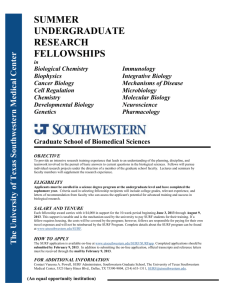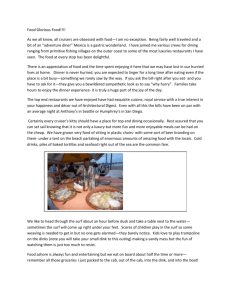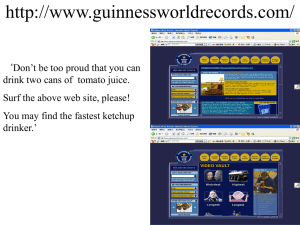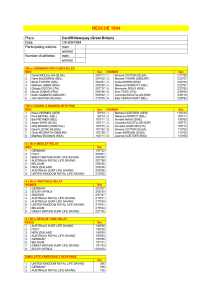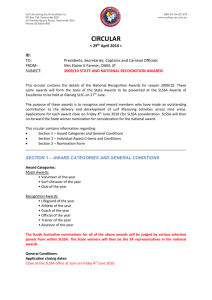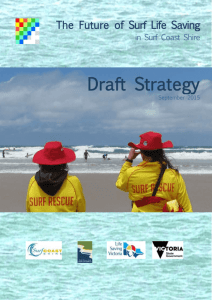The Transition from Participant to Leader in Surf Life Saving: a
advertisement
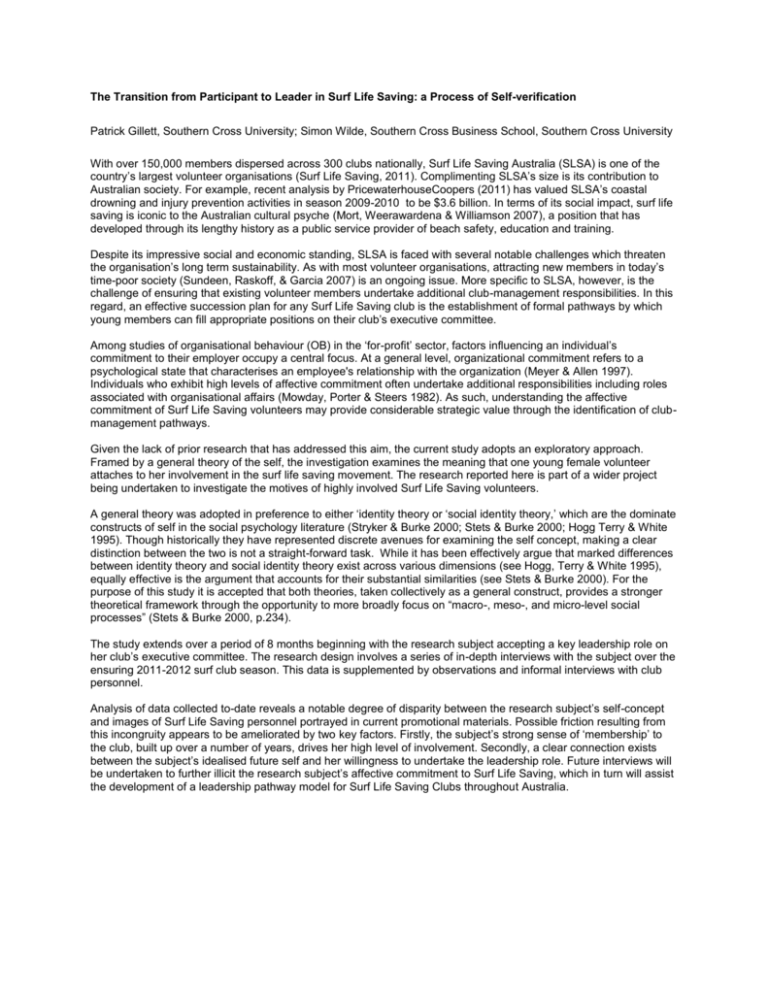
The Transition from Participant to Leader in Surf Life Saving: a Process of Self-verification Patrick Gillett, Southern Cross University; Simon Wilde, Southern Cross Business School, Southern Cross University With over 150,000 members dispersed across 300 clubs nationally, Surf Life Saving Australia (SLSA) is one of the country’s largest volunteer organisations (Surf Life Saving, 2011). Complimenting SLSA’s size is its contribution to Australian society. For example, recent analysis by PricewaterhouseCoopers (2011) has valued SLSA’s coastal drowning and injury prevention activities in season 2009-2010 to be $3.6 billion. In terms of its social impact, surf life saving is iconic to the Australian cultural psyche (Mort, Weerawardena & Williamson 2007), a position that has developed through its lengthy history as a public service provider of beach safety, education and training. Despite its impressive social and economic standing, SLSA is faced with several notable challenges which threaten the organisation’s long term sustainability. As with most volunteer organisations, attracting new members in today’s time-poor society (Sundeen, Raskoff, & Garcia 2007) is an ongoing issue. More specific to SLSA, however, is the challenge of ensuring that existing volunteer members undertake additional club-management responsibilities. In this regard, an effective succession plan for any Surf Life Saving club is the establishment of formal pathways by which young members can fill appropriate positions on their club’s executive committee. Among studies of organisational behaviour (OB) in the ‘for-profit’ sector, factors influencing an individual’s commitment to their employer occupy a central focus. At a general level, organizational commitment refers to a psychological state that characterises an employee's relationship with the organization (Meyer & Allen 1997). Individuals who exhibit high levels of affective commitment often undertake additional responsibilities including roles associated with organisational affairs (Mowday, Porter & Steers 1982). As such, understanding the affective commitment of Surf Life Saving volunteers may provide considerable strategic value through the identification of clubmanagement pathways. Given the lack of prior research that has addressed this aim, the current study adopts an exploratory approach. Framed by a general theory of the self, the investigation examines the meaning that one young female volunteer attaches to her involvement in the surf life saving movement. The research reported here is part of a wider project being undertaken to investigate the motives of highly involved Surf Life Saving volunteers. A general theory was adopted in preference to either ‘identity theory or ‘social identity theory,’ which are the dominate constructs of self in the social psychology literature (Stryker & Burke 2000; Stets & Burke 2000; Hogg Terry & White 1995). Though historically they have represented discrete avenues for examining the self concept, making a clear distinction between the two is not a straight-forward task. While it has been effectively argue that marked differences between identity theory and social identity theory exist across various dimensions (see Hogg, Terry & White 1995), equally effective is the argument that accounts for their substantial similarities (see Stets & Burke 2000). For the purpose of this study it is accepted that both theories, taken collectively as a general construct, provides a stronger theoretical framework through the opportunity to more broadly focus on “macro-, meso-, and micro-level social processes” (Stets & Burke 2000, p.234). The study extends over a period of 8 months beginning with the research subject accepting a key leadership role on her club’s executive committee. The research design involves a series of in-depth interviews with the subject over the ensuring 2011-2012 surf club season. This data is supplemented by observations and informal interviews with club personnel. Analysis of data collected to-date reveals a notable degree of disparity between the research subject’s self-concept and images of Surf Life Saving personnel portrayed in current promotional materials. Possible friction resulting from this incongruity appears to be ameliorated by two key factors. Firstly, the subject’s strong sense of ‘membership’ to the club, built up over a number of years, drives her high level of involvement. Secondly, a clear connection exists between the subject’s idealised future self and her willingness to undertake the leadership role. Future interviews will be undertaken to further illicit the research subject’s affective commitment to Surf Life Saving, which in turn will assist the development of a leadership pathway model for Surf Life Saving Clubs throughout Australia. References Hogg, MA, Terry, DJ & White, KM 1995, A tale of two theories: a critical comparison of identify theory with social identify theory, Social Psychology Quarterly, vol. 58, no. 4, pp. 225-269. Meyer, JP & Allen, NJ 1997, Commitment in the workplace. Thousand Oaks, CA: Sage. Mort, GS, Weerawardena, J & Williamson, B 2007, Branding in the non-profit context: the case of Surf Life Saving Australia, Australasian Marketing Journal, vol, 15, no. 2, pp.108-119. Mowday, RT, Porter, L & Steers, RM 1982 Employee-Organization linkages: the psychology of commitment, absenteeism, and turnover, San Diego, CA, Academic Press. Pricewaterhouse Coopers 2001, What is the economic contribution of Surf Life Saving in Australia, accessed 10 October 2011 from http://www.sls.com.au/content/surf-life-saving%E2%80%99s-economic-contribution-communityvalued-36-billion Stets, JE & Burke, PJ 2000, Identity theory and social identity theory, Social Psychology Quarterly, vol. 63, no. 3, pp. 224-237. Stryker, S & Burke, PJ 2000, The past, present and future of an identity theory, Social Psychology Quarterly, vol. 63, no. 4, pp. 284-297. Sundeen, RA, Raskoff, SA & Garcia, MC 2007 Differences in perceived barriers to volunteering to formal organizations: Lack of time versus lack of interest, Nonprofit Management & Leadership, vol. 17, no. 3, pp. 279-300. Surf Life Saving 2011, Surf Life Saving: who we are, accessed 22 September 2011 from http://www.sls.com.au/whowe-are/corporate-information
